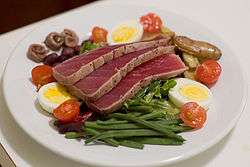Searing

Searing (or pan searing) is a technique used in grilling, baking, braising, roasting, sautéing, etc., in which the surface of the food (usually meat, poultry or fish) is cooked at high temperature until a caramelized crust forms. Similar techniques, browning and blackening, are typically used to sear all sides of a particular piece of meat, fish, poultry, etc. before finishing it in the oven. To obtain the desired brown or black crust, the meat surface must exceed 150 °C (300 °F), so searing requires the meat surface be free of water, which boils at around 100 °C (212 °F).
Although often said to "lock in the moisture" or "seal in the juices", searing has been demonstrated[1] to result in a greater net loss of moisture versus cooking to the same internal temperature without first searing. Nonetheless, it remains an essential technique in cooking meat for several reasons:
- The browning creates desirable flavors through caramelization and the Maillard reaction.
- The appearance of the food is usually improved with a well-browned crust.
- The contrast in taste and texture between the crust and the interior makes the food more interesting to the palate.
Typically in grilling, the food will be seared over very high heat and then moved to a lower-temperature area of the grill to finish cooking. In braising, the seared surface acts to flavor, color and otherwise enrich the liquid in which the food is being cooked.
Sealing in the juices
The incorrect belief that searing meat "seals in the juices" is widespread and still often repeated. This theory was first put forth by Justus von Liebig,[1] a German chemist and food scientist, around 1850. The notion was embraced by contemporary cooks and authors, including Auguste Escoffier. It is more typically cited in regards to larger cuts, especially steaks and chops, of non-poultry meats such as beef, pork, lamb and tuna.
Simple experimentation can test the theory, in which two similar cuts of meat are cooked, one of which is seared and one of which is not. Each piece is then cooked normally in a preferred method (roasting, baking, grilling etc.) until each reaches exactly the same predetermined internal temperature. They are then weighed to see which lost more moisture. As early as the 1930s, such experiments were carried out; the seared roasts lost the same amount of moisture or more. (Generally more liquid is lost, since searing exposes the meat to higher temperatures that destroy more cells, in turn releasing more liquid.)[2]
Moisture in liquid and vapor form continues to escape from a seared piece of meat. For this reason, searing is sometimes done at the end of the cooking process to gain the flavor benefits of the Maillard reaction, as well as the benefits of cooking for a greater duration with more moistness.